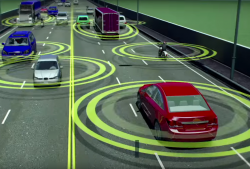
— What would happen if driverless cars were hacked and brought to a halt in rush hour traffic in New York?
Research conducted by the Georgia Institute of Technology and Multiscale Systems examined the consequences by using physics to simulate what hackers could do to internet-connected cars on a large scale.
The research looked at the gridlock that would be possible in a major city if hackers bypassed cybersecurity systems and stranded driverless cars and their occupants.
Previous research focused on what could occur if a single vehicle was hacked, such as the case of a Jeep Cherokee controlled by hackers sitting in a basement.
Fortunately those hackers were friendly security researchers, but even though the driver knew the hackers were trying to take control, he was still in for a shock when they did it.
Georgia Tech researchers say data breaches have greatly increased over the past four years even though the issue of cybersecurity has never been taken more seriously. Unlike a hacked home computer that may cause a person major headaches, stalled hacked vehicles could block entire city streets.
According to the research, the hacking simulations put traffic in Manhattan to a complete stop, causing researchers to say the simulations "froze traffic in Manhattan nearly solid, and it would not even take that to wreak havoc."
Even using conservative estimates, stalling only 20% of vehicles during rush hour would totally freeze traffic, which means not all vehicles on the road would need to be connected to the internet.
If just 10 percent of driverless cars were hacked at rush hour, this will be enough to prevent emergency vehicles from responding quickly to calls and leave people without the help they desperately need.
In other large cities things could be worse if those cities don't have large grids to keep traffic properly flowing, with researchers naming Atlanta, Boston and Los Angeles as examples.
The researchers also said they only considered static traffic situations to determine if the roads would either be blocked or unblocked. However, blocked roads cause traffic to enter other roads, so the percentage of stalled vehicles wouldn't need to be high.
Then there is what could happen once 20% of cars stall during rush hour traffic and the effect vehicle occupants would have once they leave their vehicles and become pedestrians.
Results of the connected car study were published in the journal Physical Review E.




